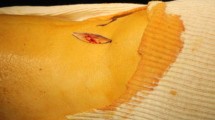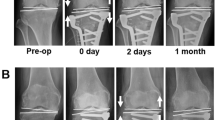Abstract
We analyzed the difference in angle-correction accuracy and initial stability between open-wedge (OWO) and closed-wedge tibial valgus osteotomy (CWO). Five fresh-frozen pairs of human cadaver lower limbs were used; their bone mineral density (BMD) was measured with DEXA and a planned 7° valgus osteotomy was performed, either with an open (right knees) or closed (left knees) technique. All knees for osteotomy were fixed with a rigid locked plate. In OWO, tricalcium phosphate (TCP) wedges were inserted. The knees were subjected to an increasing cyclic axial load until failure, while measuring the relative displacement of the bony segments with roentgen stereophotogrammetric analysis. The mean postoperative valgus correction angle was 9.5°±2.8° for CWO (over-correction of 2.5°) and 6.2°±2.0° for OWO (under-correction of 0.8°) (P =0.08). The data of displacement under load bearing showed no significant differences in rotations and translations in any direction. No significant correlation between BMD and the moment of failure was found (P =0.27). This study has shown that both methods gave an acceptable correction with a high variation of postoperative correction angles. There was a tendency for over-correction in the CWO group but no significant difference was found. There was no difference in initial stability between CWO and OWO with a rigid locked-plate fixation.




Similar content being viewed by others
References
Akamatsu Y, Koshino T, Saito T, Wada J (1997) Changes in osteosclerosis of the osteoarthritic knee after high tibial osteotomy. Clin Orthop 334:207–214
Aronson AS, Hoist L, Selvik G (1974) An instrument for insertion of radiopaque bone markers. Radiology 113:733–734
Billings A, Scott DF, Camargo MP, Hofmann AA (2000) High tibial osteotomy with a calibrated osteotomy guide, rigid internal fixation, and early motion. Long-term follow-up. J Bone Joint Surg Am 82A:70–79
Closkey RF, Windsor RE (2001) Alterations in the patella after a high tibial or distal femoral osteotomy. Clin Orthop 389:51–56
Coventry MB, Ilstrup DM, Wallrichs SL (1993) Proximal tibial osteotomy. A critical long-term study of eighty-seven cases. J Bone Joint Surg Am 75:196–201
Fowler JL, Gie GA, MacEachern AG (1991) Upper tibial valgus osteotomy using a dynamic external fixator. J Bone Joint Surg Br 73:690–691
Hernigou P, Medevielle D, Debeyre J, Goutallier D (1987) Proximal tibial osteotomy for osteoarthritis with varus deformity. A ten to thirteen-year follow-up study. J Bone Joint Surg Am 69:332–354
Hernigou P, Ovadia H, Goutallier D(1992) Mathematical modeling of open wedge tibial osteotomy and correction tables. Rev Chir Orthop Reparatrice Appar Mot 78:258–263
Insall JN, Joseph DM, Msika C (1984) High tibial osteotomy for varus gonarthrosis. A long-term follow-up study. J Bone Joint Surg Am 66:1040–1048
Ivarsson I, Myrnerts R, Gillquist J (1990) High tibial osteotomy for medial osteoarthritis of the knee. A 5 to 7 and 11 year follow-up. J Bone Joint Surg Br 72:238–244
Kärrholm J (1989) Roentgen stereophotogrammetry: Review of orthopedic applications. Acta Orthop Scand 60:491–503
Kettelkamp DB, Wenger DR, Chao EY, Thompson C (1976) Results of proximal tibial osteotomy. The effects of tibiofemoral angle, stance-phase flexion-extension, and medial-plateau force. J Bone Joint Surg Am 58:952–960
Koshino T, Morii T Wada J et al (1989) High tibial osteotomy with fixation by a blade plate for medial compartment osteoarthritis of the knee. Orthop Clin North Am 20:227–243
van Loon CJ, de Waal Malefijt MC, Breemans E, Veth RP (1995) Complications of high tibial osteotomy. Orthop Int Ed 3:484–488
Lobenhoffer P, Simoni CD, Staubli AE (2002) Open-wedge high tibial osteotomy with rigid plate fixation. Tech Knee Surg 2:1–11
Magyar G, Toksvig-Larsen S, Lindstrand A (1998) Open wedge tibial osteotomy by callus distraction in gonarthrosis: operative technique and early results in 36 patients. Acta Orthop Scand 69:147–151
Maquet P (1976) Valgus osteotomy for osteoarthritis of the knee. Clin Orthop 120:143–148
Odenbring S, Egund N, Hagstedt B et al (1991) Ten-year results of tibial osteotomy for medial gonarthrosis. The influence of overcorrection. Arch Orthop Trauma Surg 110:103–108
Sprenger TR, Doerzbacher JF (2003) Tibial osteotomy for the treatment of varus gonarthrosis. Survival and failure analysis to twenty-two years. J Bone Joint Surg Am 85A:469–474
Author information
Authors and Affiliations
Corresponding author
Rights and permissions
About this article
Cite this article
Gaasbeek, R.D.A., Welsing, R.T.C., Verdonschot, N. et al. Accuracy and initial stability of open- and closed-wedge high tibial osteotomy: a cadaveric RSA study. Knee Surg Sports Traumatol Arthrosc 13, 689–694 (2005). https://doi.org/10.1007/s00167-004-0599-0
Received:
Accepted:
Published:
Issue Date:
DOI: https://doi.org/10.1007/s00167-004-0599-0




